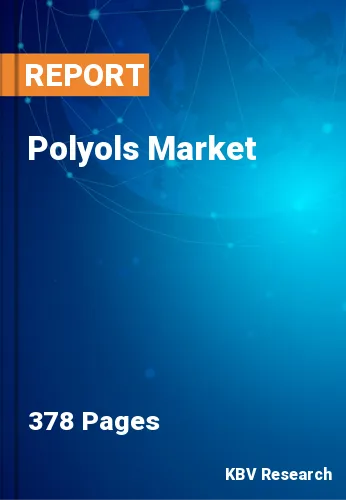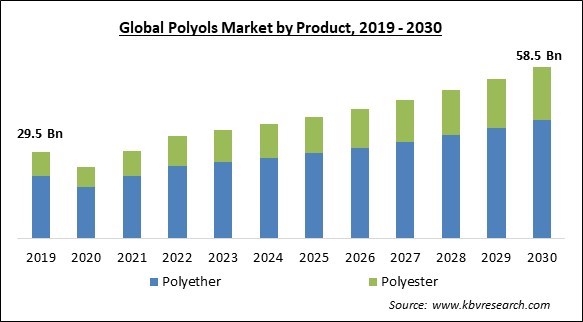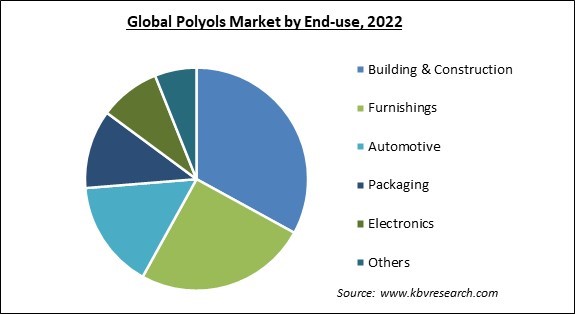
The Global Polyols Market size is expected to reach $58.5 billion by 2030, rising at a market growth of 6.8% CAGR during the forecast period. In the year 2022, the market attained a volume of 15,881.2 Kilo Tonnes, experiencing a growth of 5.4% (2019-2022).
Elastomer polyols are essential in formulating high-performance elastomers with a wide range of properties Thus, Elastomers segment acquired $6,618.0 million revenue in the market in 2022. Elastomers are polymers that combine plastic's rigidity with rubber's flexibility. Due to their superior mechanical and chemical effects, low cost, and high durability, polyol-based elastomers are utilized in molded rubber components in numerous industries, including construction and building materials, clothing and footwear, automotive, packaging, furnishings, appliances, marine, medical, and electronics. The choice of the specific elastomer polyol depends on the desired characteristics of the final product, including its flexibility, durability, resistance to environmental factors, and temperature tolerance. These materials are crucial in industries where elastomers are used for their unique mechanical properties. Some of the factors impacting the market are growing application of polyurethane in the automotive industry, expansion of the packaging industry, and stringent environmental regulations for polyurethane foam production.

The automotive industry continuously strives to reduce vehicle weight to improve fuel efficiency and meet emission standards. Polyurethane materials are valued for their lightweight properties and are used in various parts to reduce vehicle weight. This trend has driven the adoption of polyurethane and polyols in automotive applications. Polyurethane produces safety components like energy-absorbing foam in bumpers and side-impact protection systems. Enhanced safety requirements have led to the increased use of polyurethane in automotive safety applications. There is a growing focus on sustainable materials in the automotive industry. Bio-based polyols derived from renewable sources are being developed as alternatives to petroleum-based polyols. These bio-based polyols align with the automotive industry's sustainability goals. Additionally, the packaging industry is increasingly concentrated on sustainability and reducing its environmental impact. Bio-based polyols, derived from renewable sources, are being used to produce more eco-friendly polyurethane packaging materials. These sustainable materials align with consumer preferences and regulatory requirements for eco-conscious packaging. Polyurethane foam, formulated with specific polyols, is used in temperature-sensitive packaging applications. This insulation helps maintain the desired temperature for products such as fresh produce, pharmaceuticals, and chemicals during transit. The growth of industries requiring temperature-controlled packaging has boosted the market.
However, several regulatory agencies, especially in North America and Europe, have strict restrictions governing polyurethane foam production. Overexposure to these hazardous pollutants could harm a person's skin, eyes, nose, throat, and lungs. As a result, several preventative measures are implemented in locations where there is a chance of exposure to diisocyanate airborne concentrations, including the use of mechanical controls (local exhaust ventilation), suitable personal protective gear (respiratory protection), and other workplace procedures (proper handling and storage). Compliance with waste disposal regulations can add to operational costs and complexity. Environmental regulations may encourage or require energy-efficient manufacturing processes. These requirements result in additional costs, therefore reducing the producers' profit margins, and thus being a major restraint for the market’s growth.
By end-use, the market is divided into building & construction, furnishings, automotive, packaging, electronics, and others. The building and construction sector acquired the highest revenue share in the market in 2022. Polyols, particularly when used in conjunction with isocyanates, play a crucial role in the production of polyurethane-based construction materials. These materials are known for their versatility, durability, and performance, making them a common choice in various construction applications. Polyol can be incorporated into concrete mixes to improve its properties. They can enhance the workability of concrete, reduce water content, and increase its resistance to freeze-thaw cycles. Polyols can also be used in self-leveling concrete to improve flow characteristics. These are used in the formulation of waterproofing membranes and materials. These materials are essential for protecting buildings from water ingress, particularly in areas like basements and roofs.

Based on application, the market is fragmented into rigid foam, flexible foam, coatings, adhesives & sealants, elastomers, and others. In 2022, the flexible foam segment held the highest revenue share in the market. Flexible foams are commonly used as cushioning materials for furniture, bedding and beds, seating, and other soft products in various end-use industries, including furniture and mattresses, automotive, baggage and luggage, footwear and textiles, household appliances, engineering, and packaging. Polyether and polyester polyols are both utilized in the production of flexible foams. The average density of these foams is between 1.5 and 3 lb/ft3. The high durability, resilience, energy absorption, handling strength, enhanced thermal insulation, and superior mechanical properties of polyol-based flexible foam will likely contribute to its demand from various industries over the forecast period.
On the basis of product, the market is segmented into polyether and polyester. The polyester segment acquired a substantial revenue share in the market in 2022. Polyester polyols have high tensile strength and stress-absorbing properties, owing to which they are widely employed in vibration-dampening applications. Polyurethane, urethane, and polyisocyanurate use utilize both polyester and polyether polyols. Growing demand for PU-based foams and coatings, glues, sealants, and elastomers from multiple end-use industries, such as automobiles, textiles, insulation, packaging, electronics, and gadgets, will contribute to the sector's growth over the forecast period.
| Report Attribute | Details |
|---|---|
| Market size value in 2022 | USD 34.8 Billion |
| Market size forecast in 2030 | USD 58.5 Billion |
| Base Year | 2022 |
| Historical Period | 2019 to 2021 |
| Forecast Period | 2023 to 2030 |
| Revenue Growth Rate | CAGR of 6.8% from 2023 to 2030 |
| Number of Pages | 378 |
| Number of Table | 710 |
| Quantitative Data | Volume in Kilo Tonnes, Revenue in USD million, and CAGR from 2019 to 2030 |
| Report coverage | Market Trends, Revenue Estimation and Forecast, Segmentation Analysis, Regional and Country Breakdown, Companies Strategic Developments, Company Profiling |
| Segments covered | End-use, Product, Application, Region |
| Country scope | US, Canada, Mexico, Germany, UK, France, Russia, Spain, Italy, China, Japan, India, South Korea, Australia, Malaysia, Brazil, Argentina, UAE, Saudi Arabia, South Africa, Nigeria |
| Growth Drivers |
|
| Restraints |
|
Region-wise, the market is analyzed across North America, Europe, Asia Pacific, and LAMEA. In 2022, the Asia Pacific region registered the highest revenue share in the market. The expanding automotive industry and rising polymer consumption are expected to be major market drivers in the region. Rising construction activities and investments in the automotive and other manufacturing industries drive the region's market. In addition, accelerated urbanization, high infrastructure growth, and changing lifestyles, all of which are attributable to the demand for the furnishings and e-commerce industries in the region, have contributed to the development of the market.
Free Valuable Insights: Global Polyols Market size to reach USD 58.5 Billion by 2030
The market research report covers the analysis of key stake holders of the market. Key companies profiled in the report include The Dow Chemical Company, BASF SE, Vertellus, Huntsman Corporation, Lanxess AG, Mitsui Chemicals, Inc., Stepan Company, Koch Industries, Inc. (Invista BV), Tosoh Corporation, and Shell plc.
By End-use (Volume, Kilo Tonnes, USD Million, 2019-2030)
By Product
By Application (Volume, Kilo Tonnes, USD Million, 2019-2030)
By Geography (Volume, Kilo Tonnes, USD Million, 2019-2030)
This Market size is expected to reach $58.5 billion by 2030.
Expansion of the packaging industry are driving the Market in coming years, however, Stringent environmental regulations for polyurethane foam production restraints the growth of the Market.
The Dow Chemical Company, BASF SE, Vertellus, Huntsman Corporation, Lanxess AG, Mitsui Chemicals, Inc., Stepan Company, Koch Industries, Inc. (Invista BV), Tosoh Corporation, and Shell plc.
In the year 2022, the market attained a volume of 15,881.2 Kilo Tonnes, experiencing a growth of 5.4% (2019-2022).
The Polyether segment is leading the Market by Product in 2022 thereby, achieving a market value of $40.4 billion by 2030.
The Asia Pacific region dominated the Market by Region in 2022, and would continue to be a dominant market till 2030; thereby, achieving a market value of $32.4 billion by 2030.
Our team of dedicated experts can provide you with attractive expansion opportunities for your business.
